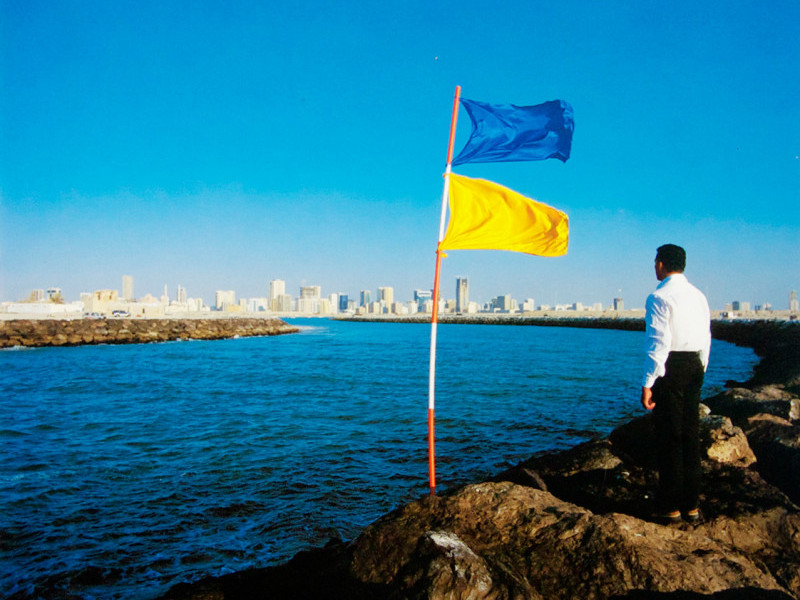
Hall of Reflections, 2002
Taraneh Hemami
Hall of Reflections, 2002
Installation view
search


Taraneh Hemami
Hall of Reflections, 2002
Installation view
The Space of Memory
Taraneh Hemami's "Hall of Reflections", Remembrances of Iranian Immigrants
Photographs frequently function as the link between past and present for people who have migrated from one place to another. The few personal photographs hurriedly gathered up during time of turmoil, chosen to accompany them through life changing experiences, document the steps taken in the journey from the country of origin to a new home in a foreign land. Simple images taken of family gatherings are sources of memory, bringing to mind the scent of home, the taste of a favourite food, snippets of conversation in the native tongue, a sense of belonging. As Seremetakis observes "Memory as a distinct meta-sense, transports, bridges and crosses all the other senses." Photographs also document the transitional stages of displacement and the formation of a new identity. Mark the experience of displacement and replacement into a different environment. For the first generation of immigrants the liminal spaces of past and present merge in these images. For their children and grandchildren however, the distance between these two points can only be bridged by the narratives passed on from one generation to the next.
In H Hall of Reflections", the photographs of the individual men, women, and children in addition to fragments of Persian and English personal writings collected through workshops and personal interviews with members of the Iranian community in Northern California, bridge the generational abyss between those who have first hand memories of home in Iran and the experience of migration to the United States, and the younger generation whose only memories are derived from shared family stories and photographs.
Taraneh Hemami has gone far beyond a mere documentation of the collected materials. She has transformed the individual verbal and visual narratives into a public artwork of text and image. Indeed, in this installation Hemami has expanded the space in which personal and cultural memory.
is contained. The traditional gathering halls, found in the architectural spaces of Iran and much of the Muslim world, inspired the specific form used by the artist for this work. Called' talar' in Persian, this meeting place is frequently covered with mirrored tiles. In "Hall of Reflections" installation, the many hand crafted tiles and bricks filling the space of gathering are comprised of photographic images and textual fragments in Persian and English on glass and mirrors. Through the glowing reflections of the mirrored tiles of text and image, Hemami invites her audience to embark on a journey of memory across the terrain that the people in the photographs have previously travelled. Thus, the link between past and present is conveyed through forms and materials used in the construction of the piece, as well as the oral histories and photographs of the Iranian immigrants who participated in this important project. "Hall of Reflections" makes it possible to travel across generational distance th rebv linking the historical past and the present. Yet it moves beyond generational mediations and nostalgic remembrances to record a specific place and time in the history of its people, becoming a visual documentation of the collective memory and cultural history of the Iranian immigrant communities.
Although "Hall of Reflections" has an important place within the Iranian immigrant community, the most important aspect of this work is the way it brings private stories out of isolation from within an individual family circle into a shared public. These whispers of personal history are conveyed to the viewer both through the materials used and the intimacy of their size, which calls the viewer to a closer inspection. The reflective materials and the shortened distance between object and audience allows the viewer's reflection to become an active part of the dialogu between each individual story and its observer. Aware and affected by the outsider's gaze, thE! mirrors record the viewer's interest or indifference thereby expanding the dialogiC interaction of the two beyond simple appearance. In the post 9/11 American climate of misconception, distrust and fear of the "other", these personal images offer the national and international audiences an intimate portrait of the Iranian immigrant community thereby assisting her audience to move away from misconceptions, rooted in misrepresentations of the Middle Eastern cultures and towards understanding of the nuances of similarities and differences within and among populations.
Extracts from Sharon Parker. Parker writes on the enunciatory aspects of Hemami's work; a series of remembrances, historical and human, that archives not only the narratives of the diasporic History, but the transformative possibilities that offer the sense of living; to be in other times and different spaces.

Sharjah Biennial 6